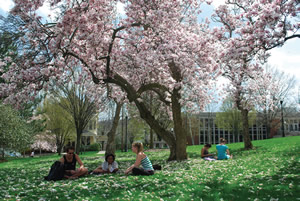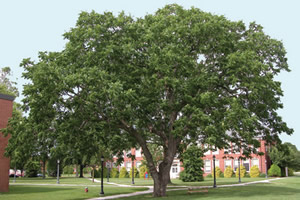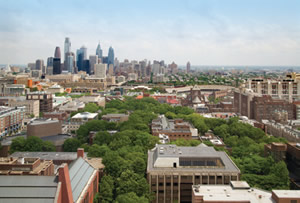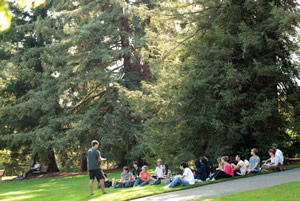Campus Arboreta: Outdoor Spaces for Learning and for Play

PHOTO COURTESY OF ARBNET
Do you realize your campus grounds are much more than just a nice setting among your buildings? How many times have you heard students referring to their campus as “beautiful” or saying “it just feels right?” What sets your campus grounds apart from the others? Are you utilizing your grounds to their fullest potential? Is your campus an outdoor classroom and a living laboratory? Do you know that your campus grounds could be an officially accredited arboretum earning distinction, opening up funding opportunities, and achieving recognition worldwide?
Become a Campus Arboretum (for Free!)
The greenspace on your campus is important for students to relax and recharge. There are numerous scientific studies that show arboreta have a strong positive impact on mental and physical health. Arboreta enhance learning and quality of life for your students and community. Your university or college can become an outdoor classroom; living laboratory; and an inspiration for a greener, healthier, and more beautiful world.
Beyond a traditional park, an arboretum focuses on horticultural display of labeled woody species for plant research and education to promote tree conservation and public awareness. Not only are arboreta beautiful, but campus departments can partner to develop participatory student learning experiences and innovative leadership and service learning internships (see the examples from accredited campus arboreta that follow). These partnerships can result in students planning and implementing outreach initiatives, beautification efforts, and educational events for K–12 students and campus visitors—all using your newly accredited arboretum!

PHOTO COURTESY OF ARBNET
The benefits of becoming an accredited campus arboretum include:
- Earn distinction for your university/college and community.
- Be recognized for achievement of specified levels of professional practice.
- Attract potential students (and faculty) with your accreditation to improve recruitment.
- Provide a richer learning experience for your students.
- Access to exclusive funding opportunities that build your capacity to provide a beautiful and engaging campus arboretum.
- Serve as a model to encourage professional development on other university/college campuses.
- Receive support and guidance for advancing to higher levels of accreditation.
- Advance the planting, study, and conservation of trees.
Delaware State University (DSU) Arboretum – Level I
“The Arboretum is used for teaching about trees and conservation to DSU students, as well as members of the public. This includes undergraduate and graduate courses such as Systematic Botany, Field Botany, Dendrology, Horticultural Plant Materials, and even an English Literature ‘nature poetry walk;’ as well as outreach programs like Master Gardener training, Teacher In-Service classes, Woodland Classroom program for elementary school children, and monthly nature walks.”— Susan Yost, Ph.D., Department of Agriculture and Natural Resources, Delaware State University, Dover, DE
Campus Arboretum at Washington & Jefferson College – Level I
“Accreditation…gives our Campus Arboretum a benchmark for progress toward a more ecological, educational, and aesthetic living and learning environment. This accreditation substantiates our efforts and provides more support for ecological landscaping on the campus and broad educational programming for the community. We are now on the map for global arboreta and want to be a welcome destination for people both young and old.”—Dr. Jason Kilgore (Biology), Washington & Jefferson College, Washington, PA
Palomar College – Level I
At Palomar College in San Marcos, CA, the arboretum accreditation allows the college to work closer and more efficiently with other like-minded institutions on plant-based conservation and education projects from across the country and the globe. It also means that the plants on campus have more than just a dollar value, it means they are now, even if only in a very small way, contributing to local and global education and conservation work. It means that Palomar recognizes that the plants on the main campus are not just landscaping, they are part of a classroom and that we recognize the importance of landscaping responsibly with non-invasive plants, natives and plants adapted to our climate.
Arboretum at the University of Pennsylvania – Level II

PHOTO COURTESY OF ARBNET
The Arboretum at the University of Pennsylvania in Philadelphia has established partnerships with various schools, centers, departments, and groups throughout the university, including, but not limited to, Penn Design, School of Arts and Sciences, Masters of Environmental Studies, Masters of Public Health, Development & Alumni Relations, Staff & Student Eco-Reps and the Kite & Key Society. Students use Penn Plant Explorer for research projects within various programs. Externally, the Arboretum at Penn collaborates with the U.S. Forest Service, Philadelphia Parks & Recreation, Pennsylvania Horticultural Society, UC Green, UC District and others on programs related to Penn’s urban forest.
“We have been thrilled with our ArbNet Level II Arboretum accreditation. It has helped us raise the level of the conversation we have with our community around campus trees. I have had numerous people tell me they are better able to steward our trees now that we are an official arboretum. People just get it more than they did before—now we can immediately cut through the noise and people understand that trees are important in an arboretum.”— Chloe Cerwinka, landscape planner, The University of Pennsylvania
Georgia Tech Arboretum – Level II
Using the campus as a living learning laboratory, the Georgia Institute of Technology in Atlanta has developed its tree inventory and stormwater master plan as part of the larger vision to build and define a performance landscape. As an example of this, Georgia Tech hosted a training workshop combining the i-Tree models with its current stormwater model to further evaluate the effects of trees on the proposed stormwater management system. The i-Tree Hydro model was developed by stormwater engineers and U.S. Forest Service scientists. It simulates the effects of changes in tree and impervious cover characteristics within a defined area of interest on stream flow and water quality.
Georgia Tech Arboretum has multiple methods of labeling the trees on campus: printed brochures, physical tags, an open-access web based GIS inventory, and an Augmented Reality (AR) walking tour. “We are really excited to be accredited as a Level II Arboretum. “The Georgia Tech Arboretum will provide a platform for the development of educational tools to define the value and performance of individual trees and the collective forest in our urban landscape.”—Jason Gregory, senior educational facilities planner and landscape architect with Capital Planning and Space Management, Georgia Tech
UC Davis – Level IV

PHOTO COURTESY OF ARBNET
UC Davis in California incorporated into their plan the GATEways Outreach (Gardens, Arts, and the Environment), a master planning framework for the arboretum as an inviting campus portal and connection to campus research and teaching, with educational landscapes, public art, outreach centers, interpretive exhibits, performance spaces, and gathering areas. New GATEways landscapes include the Native American Contemplative Garden (partnership with the Native American Studies Department), Oak Discovery Trail, Arboretum Teaching Nursery, California Rock Garden (with the Geology Department), and the Animal Science GATEway Garden (with the Animal Science Department). The GATEways initiative is designed to produce an engaging, multifaceted educational experience for campus visitors, while providing UC Davis students with leadership training and experiential learning opportunities.
Ready to Pursue Arboretum Accreditation?
There are five easy steps to becoming an accredited arboretum.
- Organize an arboretum committee or governing body (members may include faculty, grounds crew, facilities staff, students, or members of the community).
- Inventory your tree species and maintain a database (contact an arborist or horticulturist for assistance).
- Label or map your woody plants (free open source software is available for mapping).
- Organize educational events for students and the wider community using your newly created arboretum.
- Obtain ArbNet accreditation status and market and enjoy your new arboretum!
The application process to become an ArbNet accredited arboretum is easy and free. For help with the application process, contact the ArbNet coordinator at: [email protected].
ARBNET: NETWORK YOUR CAMPUS AS AN ARBORETUM
ArbNet (arbnet.org) is an interactive, collaborative, international community of arboreta and tree-focused professionals, established in 2011 to advance the planting and conservation of trees. As part of its mission to support tree-focused institutions, ArbNet provides the Arboretum Accreditation Program, the only international accreditation program dedicated to recognizing and advancing the professionalism of arboreta.
If your college/university participates in Tree Campus USA, a great next step is ArbNet accreditation. Many college campus grounds have become accredited arboreta through ArbNet. The free accreditation program facilitates the sharing of knowledge, experience, and other resources to help arboreta meet their institutional goals and works to raise professional standards. Arboreta are accredited at one of four levels, based on collections, capacity, outreach, programming, and collaboration. As of December 2017, 215 institutions worldwide have become accredited and 50 of those are college or university campus arboreta.
This article originally appeared in the College Planning & Management February 2018 issue of Spaces4Learning.